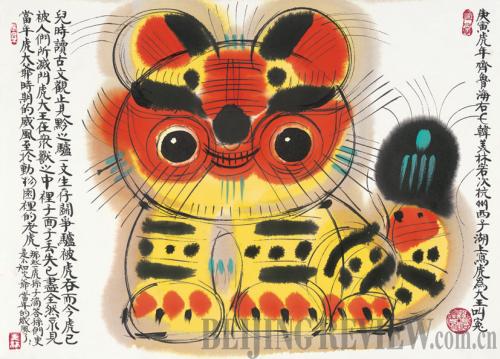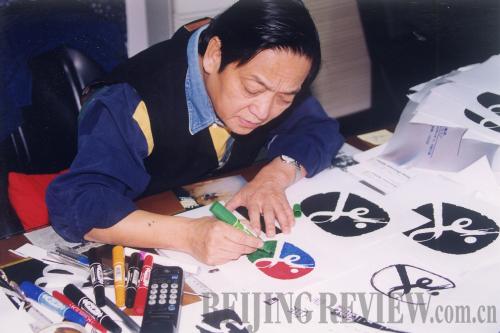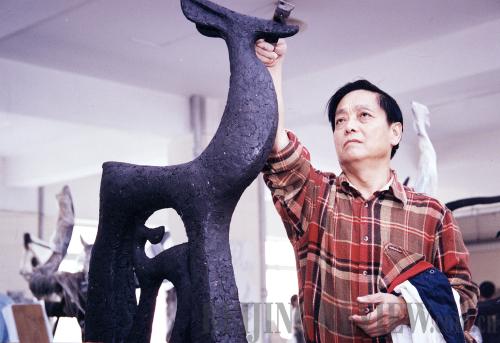Passion never dies
 |
|
This depiction of a tiger is one of Han Meilin's art works. [Courtesy of Han Meilin Art Museum] |
Han Meilin started his painting career at 13 and has never stopped his progress along his singular road for 60 years—even during harsh conditions brought about by the disastrous "cultural revolution" (1966-76). He is the first Chinese painter to have ever held a one-man exhibition in the United States. He has had an art studio named after him, the only one of its kind under the auspices of China's Artists' Association.
These kudos accrue to Han Meilin, one of the most prolific of China's contemporary painters and sculptors. Despite now being 73, he still often works for more than 18 hours a day, producing up to 200 paintings.
Born into a very poor family in 1936 in east China's Shandong Province, Han's interest in art began when he joined the army at 13. Two years later, he became a teacher of fine arts in a primary school.
 |
|
Han Meilin works in his studio. [Courtesy of Han Meilin Art Museum] |
In 1955, he was admitted to the Central Academy of Arts and Design, now part of the prestigious Tsinghua University, and graduated in 1960. From then until the disastrous "cultural revolution," when he was sent to prison and forced to stop painting because of accusation of "counter revolution" for quite a few years, he began to explore more professional methods of creative art.
But "My passion for painting never stopped even under such harsh conditions," said Han in an interview with Beijing Review. He secretly practiced painting by dipping the chopsticks into water and drawing on his trousers.
The "cultural revolution" had not ended when he was released from prison. "We still didn't have the freedom to draw anything we liked. We couldn't draw people, because that could cause a lot of problems at that time. That is how I started to draw small animals," Han said.
He gave animals human beings' feelings and emotions and made all his animals appear very lively.
Han said he tried many ways to make the animals come alive on paper. "I first wiped water on the paper and drew the picture while the paper was still wet. Then I found the ink penetrated the paper to such a degree it made the animals look very hairy."
He also tried many methods to prevent ink losing its color, such as mixing ink with soy sauce, fruit juice, tea or alcohol.
All these techniques are just painting skills, Han said, but they are not the most important part of creativity. "Love is. It is just because I experienced so much loss and suffering that I cherish love very much today." Han illustrates his point with his painting Friend in Need. It depicts a dog which kept Han company during the "cultural revolution" when he was maltreated and cared for by no one. The dog remained a loyal friend but was ultimately killed by the group of people abusing Han.
Han's sculpture series Mother and Child, which is on display at the Han Meilin Art Museum located in east Beijing's Tongzhou District, was inspired by the idea of love between mothers and children. Each mother is slender, elegant; the children, chubby and naive. They contrast incisively and vividly depict the sincerest love on earth.
In June 1979, Han held an exhibition at the National Art Museum of China, in which he displayed only pictures of small animals such as dogs and cats. The showing lasted for 21 days but attracted more than 10,000 visitors on each, including visitors from overseas. In 1980, this exhibition moved to New York City, making Han the first Chinese painter to hold an exhibition there. "All the small animals in my paintings look quite special among other art works from the "cultural revolution," and this, I think, is the main reason why my works attract foreign visitors," he said.
An senior American, after visiting the New York exhibition, told Han that he liked hunting, but had decided not to kill animals after he saw the "kind and lovely" animals depicted by the artist.
 |
|
Han Meilin works on a sculpture in his studio. [Courtesy of Han Meilin Art Museum] |
Following the New York exhibition, Han's works were also exhibited in 20 other cities across the United States. He was given the key to the city of San Diego as an honorary citizen. New York's Manhattan declared in October 1980 a Han Meilin Day. During his stay in the United States, he was also invited to speak at Harvard and Yale universities.
In 1983, six of Han's works were selected for Christmas cards issued by the United Nations. Since 1989, he has held one-man art shows in more than 20 countries.
Deep rooted
Han attributes all his achievements to the deep roots of Chinese folk art. Most of his paintings and sculptures show traditional Chinese art features.
For more than 20 years, he has been making rural forays. During the last few years of the "cultural revolution," Han traveled all over China, especially its remote areas, to collect ancient Chinese characters.
"The interest arose when I passed a bookstore in which I found a book of ancient characters and became very excited as soon as I saw their beauty," said Han. He followed this revelation with persistent efforts in this field for more than 20 years and finally published a book named The Sealed Book.
Through his visits to the countryside, Han and his assistants have also helped salvage much traditional craftsmanship as they themselves came to understand the most special features of China's folk art. In the Han Meilin Studio visitors can see this exemplified in many bowls and bottles made on the premises. Some are works-in-progress while others have been finished to high artistic levels.
From 1979 to 2001, Han held five exhibitions in the National Art Museum of China, witnessing different development phases in China. The latest in 2001, with more than 3,000 artworks, filled 11 exhibition halls, the largest Museum showing ever up to that time. In 1989, the Han Meilin Art Studio was set up, the first art studio in China named after an artist and the only one under the auspices of the Artists Association of China.
In 2005, Hangzhou Han Meilin Art Gallery was built up along the beautiful West Lake of Hangzhou, capital city of east China's Zhejiang Province. In 2008, the Han Meilin Art Museum was set up in Beijing. It gathers together works of fine arts by Han and his assistants and students ranging from Chinese painting, calligraphy, sculpture, pottery, wood carving to bronzes and paper cutting.
After 60 years' of experiences in this field, Han has his own ideas about art. "Art must have its own unique identity, which for a Chinese artist includes roots in the Chinese nation," he said.
 0
0 







Go to Forum >>0 Comments